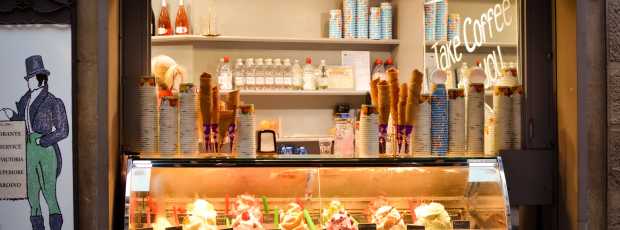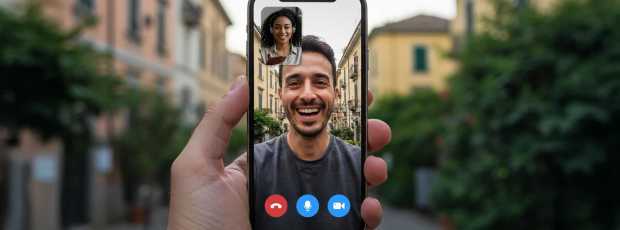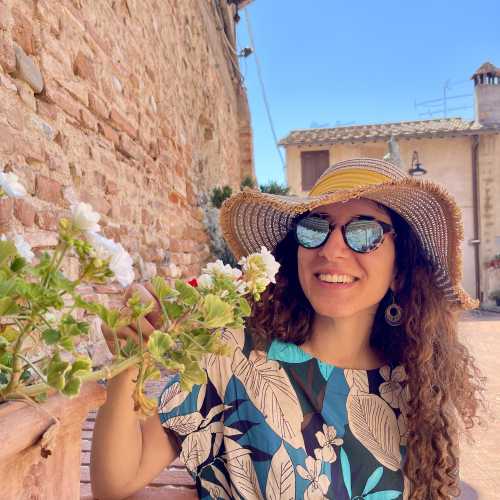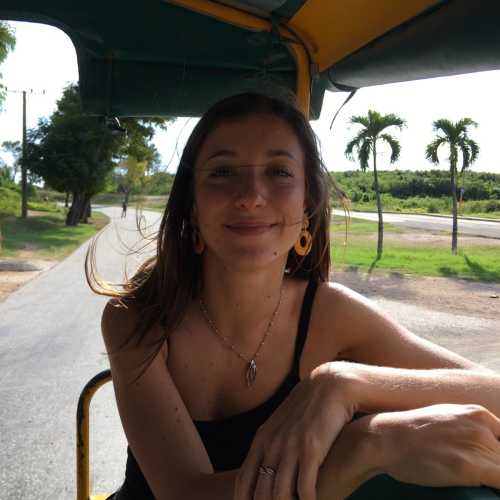What an absolutely wonderful tour with Marilisa in Florence! She is very welcoming, engaging and informative. From the moment we started our walking tour she pointed out special gems that most people would walk right by.Brenda, Florence, 2025
Go Beyond Florence on a Private Day Trip
Private tours, designed around you
Table Of Contents
- Quick Picks: Fast Wins For Your First Florence Day Out
- Classic Florence Day Trips You Should Experience
- Nature and Outdoor Escapes: Rolling Hills and Vineyard Roads
- Food and Market Day Trips: Eating Through The Tuscan Heartland
- Historic and Cultural Towns: Time Travel By Train
- Seasonal and Festival Trips: When Tuscany Changes Mood
- Overrated Trips and Their Smarter Alternatives
- Practical Tips For Planning Your Florence Day Trips
- Frequently Asked Questions About Florence Day Trips
- A Perfect Day Out Under the Tuscan Sun
The espresso goes down fast at the counter, the barista already knows the order, and there's a train ticket tucked into a back pocket. Not heading to the Mercato Centrale today. Not helping at the cousin's deli. Today's about catching that train to somewhere quieter, where the hills roll instead of the tourist crowds, and lunch takes three hours because nobody's watching the clock. Out beyond the city, the Tuscan hills start to unfold, green in spring, gold by autumn, reminding you why people fall in love with this landscape.
Florence gives you everything until it gives you too much. The shortcuts between Santo Spirito and Santa Croce get memorized, the tourist bottlenecks become predictable, and eventually the craving hits for space, for air, for a piazza where the locals outnumber the selfie sticks. That's when planning Florence day trips becomes essential. Same with the walled towns, the vineyard roads, and those medieval centers where time moves differently.
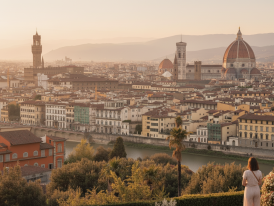
Dawn light over Piazzale Michelangelo with Arno and hills
These aren't bucket list destinations engineered for Instagram. They're the places Florentines escape to on free weekends when the city feels too loud, when the need hits for pecorino that's still warm from the wheel, or when someone suggests a long lunch under the vines and nobody argues. Most Florence day trips start at the train station, cost less than a decent dinner, and return in time for aperitivo. Some need transportation after the train. Others are walkable from the platform. All of them stretch an afternoon into something that feels longer than it is, in exactly the right way.
These incredible day trips offer everything from wine tasting in Chianti to wandering medieval streets where the Middle Ages still feel present. Whether it's just a day or a few-day trip strung together, any Florence Experience means having access to some of the best day trips from Florence that Italy offers.
Quick Picks: Fast Wins For Your First Florence Day Out
Some days, you just want an easy choice over your first coffee so you can grab a ticket and go. Use this section as a shortcut to match Florence day trips with how you feel right now, then jump to the full guide when something clicks. Everything here works as just a day trip from Florence.
Classic Tuscan Towns
- Pisa: best for the Leaning Tower and riverside streets
- Siena: best for medieval drama and the Piazza del Campo
- Lucca: best for city walls, markets, and slow wandering
- Arezzo: best for antiques, frescoes, and quieter piazzas
Wine Hills And Countryside
- Chianti region: best for Chianti wine, vineyard roads, and rolling hills
- Greve in Chianti: best for markets, salumi shops, and easy tastings
- Fiesole: best for Florence views, Roman ruins, and terrace afternoons
- Impruneta area: best for countryside hikes and olive groves
Food And Market Lovers
- Greve in Chianti: best for Saturday markets and butcher counters
- San Gimignano: best for towers, saffron, and gelato stops
- Arezzo: best for stews, sweets, and monthly antiques markets
- Livorno: best for fresh seafood and a working port feel
Hidden Gems And Quiet Towns
- Pistoia: best for Romanesque churches and busy local markets
- Certaldo: best for medieval streets without big crowds
- Volterra: best for Etruscan history and hilltop drama
- Fiesole: best for quiet trails and gardens just above the city
Season And Festival Trips
- Siena in summer: best for Palio energy and contrade pride
- Arezzo in June and September: best for the Giostra del Saracino
- Chianti in autumn: best for the harvest season and wine production
- Lucca in winter: best for Christmas markets on the walls
Not Just Another Place on the List
Experience it through hidden corners and stories most visitors miss.
Classic Florence Day Trips You Should Experience
These are the trips every Florentine takes eventually, usually more than once. Trains run often, there is plenty to see without turning the day into a marathon, and each town offers a different piece of central Italy. These amazing day trips from Florence showcase the best of central Italy, and knowing the best things to do in Florence makes planning easier.
Pisa: Beyond The Leaning Tower
Time from Florence: About 50 to 70 minutes by regional train
Best for: the Leaning Tower, cathedral complex, riverside streets
Why go: See the famous tower on your own time, then slip into a quieter city that lives beyond the postcard.
What to do
- Walk the Piazza dei Miracoli early, before the buses arrive
- Visit the cathedral and baptistery while the crowds are thin
- Head toward the Arno to explore quieter local streets
- Wander past palazzi with peeling paint and iron balconies
Pisa gets written off as a selfie stop, which misses the point. Yes, the Leaning Tower leans. Yes, tourists do that pushing pose. Arrive on an early train from Florence, and the Piazza dei Miracoli belongs to maybe twenty people for the first half hour before the groups roll in. That window matters. Walk the Campo dei Miracoli, take in the cathedral and baptistery without elbows in your ribs, then leave before the crowds thicken. Head toward the Arno, where the city lives at a softer pace, with quiet courtyards and laundry lines instead of tour groups.

Morning at Leaning Tower and cathedral with minimal crowds
How to get there: Regional trains from Firenze Santa Maria Novella to Pisa Centrale, then follow the signs to the tower on foot or by local bus.
Siena: History Written in Stone and Song
Time from Florence: About 1 hour 15 minutes by bus, 1 hour 30 to 1 hour 45 by regional train
Best for: medieval streets, Piazza del Campo, contrade culture, day trips with depth
Why go: The Palio, the shell-shaped piazza, and the contrade turn Siena into a living history lesson that never feels staged.
What to do
- Climb into the historic center from the station or bus stop
- Spend time in Piazza del Campo watching how locals use it
- Visit the Duomo and the Palazzo Pubblico if you want more context
- Walk through Contrada streets, spotting flags and fountains
When guests visit and want to understand Tuscany beyond Renaissance art, Siena gets the recommendation every time. It is medieval, fiercely proud, and still organized around the famous Palio horse race that happens twice each summer. The contrade, Siena's seventeen neighborhood districts, are not tourist folklore. They are identity, visible on every street corner. No cars in the center, just stone streets that climb and curve and suddenly open onto Piazza del Campo, a shell-shaped space sloping toward the Palazzo Pubblico, where people sit directly on the bricks and let time stretch.

Aerial view of shell-shaped Piazza del Campo
How to get there: Bus from near Santa Maria Novella to Siena historic center, or regional train from Florence to Siena station with a short bus or escalator connection into town.
Lucca: A City Within Its Walls
Time from Florence: About 1 hour 20 to 1 hour 35 by regional train
Best for: intact city walls, easy bike rides, relaxed wandering
Why go: Walk or cycle a complete loop over a medieval city and spend the day doing very little without feeling like you missed anything.
What to do
- Rent a bike near the station and ride the full circuit on the walls
- Pause at viewpoints that look down on churches and piazzas
- Wander narrow streets and striped facades inside the walls
- Sit in a square with a coffee and watch local rhythms
For doing absolutely nothing while feeling completely satisfied, Lucca wins. The city walls stay intact, tree-lined, and wide enough for biking or walking without ever feeling crowded. Inside the walls, Lucca feels self-contained and human-scaled. Piazzas host markets, churches show off striped fronts, and laundry lines stretch between buildings. There is no single sight shouting for attention. You just wander, eat, and sit in the shade. This lovely town makes for one of the most peaceful Florence day trips.

Tree-lined path on top of Lucca's Renaissance walls
How to get there: Direct regional trains from Firenze Santa Maria Novella to Lucca station, a short walk from the walls.
These day trips from Florence deliver vineyard walks and the kind of quiet that reminds you Tuscany isn't just art cities but also the countryside that feeds them.
Nature and Outdoor Escapes: Rolling Hills and Vineyard Roads
Sometimes culture and history can wait. What's needed is air, space, and green. These day trips from Florence deliver vineyard walks and the kind of quiet that reminds you Tuscany isn't just art cities but also the countryside that feeds them.
Fiesole: Terraces, Trails, and Florence Views
Time from Florence: About 25 to 30 minutes by bus
Best for: Florence skyline views, Roman ruins, gentle hikes
Why go: Trade crowded streets for hillside paths and a wide view of the city that fits into one frame.
What to do
- Ride Bus 7 up to the main piazza in Fiesole
- Visit the Roman theater and small museum near the square
- Walk terrace paths overlooking Florence below
- Follow easy trails through cypress and stone walls
Fiesole sits so close it almost feels like an elevated neighborhood, but the mood is different the minute you step off the bus. Most visitors come for the view, which delivers, yet walking past the piazza reveals trails that wind through cypresses and old walls until the city drops out of sight. These paths are not hard. They are gentle, shaded, perfect when visiting Florence starts to feel intense, and all you want is a quiet hour in the hills.

Olive groves in the Fiesole hills
How to get there: Take ATAF Bus 7 from central Florence to Fiesole’s main piazza and return on the same route.
Chianti By Train and Bus: Hills Of Vines And Stone
Time from Florence: About 1 to 1 hour 30 minutes, depending on the town and connections
Best for: Chianti wine, rolling hills, small towns between vineyards
Why go: Move through the landscape that fills postcards, then slow down enough to taste what it produces.
What to do
- Take a train toward Siena and get off at a smaller stop
- Connect by local bus to Greve, Radda, Gaiole, or Castellina
- Walk quiet roads between vineyards and stone farmhouses
- Stop at a cantina for wine tasting and a simple lunch
The Chianti region built its reputation on Chianti wine, but moving through it is its own reward. Hills covered in vines, cypress-lined roads, and stone farmhouses mark every direction. Transportation does not run constantly, so checking schedules before departure matters. Once you are there, the pace drops. Walking between vineyards, tasting Sangiovese at a cantina, sitting on a lovely outdoor terrace that looks over nothing but vines and sky, turns a simple day trip into something slower and better.
How to get there: Take a regional train from Florence toward Siena or Arezzo, then connect by local bus to your chosen Chianti town, such as Greve or Radda.
Hiking Through The Tuscan Countryside
Time from Florence: About 30 to 60 minutes by bus or car, depending on the trailhead
Best for: countryside walks, olive groves, vineyard views
Why go: Swap museum floors for farm tracks and paths that locals used long before cars.
What to do
- Start near Impruneta for routes past villas and olive groves
- Explore around Certaldo, where medieval paths link hill towns
- Choose loops that match your energy and the daylight
- Bring water and check the weather before you set out
Good walking does not require long journeys. The area between Florence and Siena, the hills around Fiesole, and the edges of the region all offer hiking trails that are accessible and clear enough for most people. These are not mountain treks. They are countryside walks through fields, forests, and vineyards. Spring and fall are ideal when the landscape either blooms or glows. Even winter on a clear day works with the right clothes.

Dirt hiking trail through Tuscan countryside
How to get there: Use regional buses from Florence toward Impruneta, Greve, or Certaldo, then follow marked local trails into the countryside.
Hungry to Taste Florence Like a Local?
From tucked-away eateries to lively markets, discover flavors worth your time.
Food and Market Day Trips: Eating Through The Tuscan Heartland
For anyone who cares about food, these are the Florence day trips that matter. Markets, cheese, wine, bread, and meals that stretch three hours because rushing would feel wrong.
Greve In Chianti: Wine, Cheese, and Terracotta Shops
Time from Florence: About 1 hour by bus
Best for: Saturday market, salumi, Chianti tastings
Why go: Spend a day in a piazza where wine, cheese, and conversation run on their own schedule.
What to do
- Visit the Saturday market in the main piazza for cheese and salami
- Step into Falorni butcher shop for wild boar salami and finocchiona
- Taste local wine at enotecas around the square
- Sit under the porticos and watch the town’s rhythm
Greve sits in the heart of the wine-producing area and knows it. The main piazza wears porticos lined with butcher shops, wine cellars, and cafés, where tasting almost everything Chianti produces becomes possible. The Falorni butcher counter hums with people buying slices and kilos of what they will cook later. Wine appears everywhere, but the best moments come at small enotecas where you order a flight, some cheese, and bread, then let the day unfold.

Market stalls in Greve's piazza with hanging salami
How to get there: Take a regional bus from the Florence bus station next to Santa Maria Novella directly to Greve in Chianti.
San Gimignano: Towers, Saffron, and Hilltop Views
Time from Florence: About 1 hour 45 to 2 hours 10 minutes by train and bus
Best for: medieval towers, saffron shops, hilltop skyline
Why go: Stand inside a skyline of stone towers, then step into shops scented with saffron from the surrounding fields.
What to do
- Walk the main streets and look up at the stone towers
- Climb at least one tower for incredible views of vineyards and hills
- Visit shops selling local saffron and bring some back for your kitchen
- Eat in side street trattorias serving delicious food away from the main drag and finish with gelato
San Gimignano is a UNESCO World Heritage Site that looks like a medieval fantasy made solid, all stone towers rising from a hilltop town surrounded by vineyards. The towers were built by rival families in the Middle Ages, each trying to outdo the other, and now they give the place its skyline. This area produces respected saffron, grown in fields around town and sold in small shops that smell like earth and spice. Anyone who cooks should buy a little and remember this hilltop town when they use it.
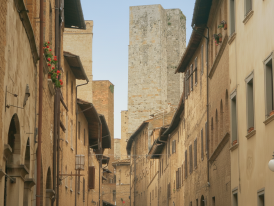
Medieval stone towers and narrow street in San Gimignano
How to get there: Take a regional train from Florence to Poggibonsi, then transfer to the local bus that climbs up to San Gimignano.
Arezzo: Markets, Antiques, and Sweet Traditions
Time from Florence: About 35 to 45 minutes by high-speed train, about 1 hour by regional train
Best for: antiques, Renaissance frescoes, traditional sweets
Why go: Experience a working city with serious art, monthly markets, and pastry counters that reward curiosity.
What to do
- Walk to Piazza Grande, the sloping main square
- Browse the antiques market on the first weekend of the month
- Visit the Basilica of San Francesco for Piero della Francesca's frescoes
- Stop at a pasticceria for cantucci and torta della nonna
Arezzo does not get the attention other Italian cities command, which works in its favor. It is a working place with important art, a massive antiques market, and pastry shops that have been open for generations. The Piero della Francesca frescoes rank among the best Renaissance paintings in central Italy, and the church around them stays calm. Between visits, you sit at a café, dip almond biscotti into Vin Santo, and watch the main square move at its own pace.
How to get there: High-speed or regional trains from Firenze Santa Maria Novella to Arezzo station, then a short walk into the historic center.
Travel Guides Can Only Take You So Far
We connect travelers with locals who shape days that actually fit your interests — not someone else’s checklist.
See how it worksHistoric and Cultural Towns: Time Travel By Train
Tuscany’s history lives in stones, bell towers, and how towns still organize themselves around festivals and squares. These day trips deliver that sense of time’s weight without needing a tour guide to explain every detail.
Siena’s Contrade and The Spirit Of The Palio
Time from Florence: About 1 hour 15 minutes by bus, 1 hour 30 to 1 hour 45 by regional train
Best for: Palio culture, neighborhood pride, festival atmosphere
Why go: See how a horse race shapes identity in a way that guidebooks never fully explain.
What to do
- Walk Contrada streets and look for flags and fountain symbols
- Visit small neighborhood museums if they are open
- Sit in Piazza del Campo and imagine the track set up for the Palio
- Time a visit near race days if you can handle the energy
The contrade are not just colors on flags. They are tribes, each with its own church, museum, and stories that reach back centuries. The Palio turns this identity outward twice each summer when bareback riders race around the Piazza del Campo, and the winning neighborhood sings for days. Even outside race season, the symbols and pride are visible on every street, and a simple walk becomes a lesson in how tradition can still shape daily life.

Colorful contrada flags on medieval buildings
How to get there: Bus or regional train from Florence to Siena, then walk into the center and follow contrade flags through the streets.
Pistoia’s Churches and Courtyards
Time from Florence: About 40 minutes by regional train
Best for: Romanesque churches, cloisters, local markets
Why go: Explore a medieval town that has not turned itself into a museum.
What to do
- Visit the Duomo di San Zeno and its silver altar
- See the terracotta frieze on the Ospedale del Ceppo
- Walk through the cloisters and quiet courtyards off the main squares
- Browse market stalls on Wednesday or Saturday mornings
Pistoia never joined the standard tourist circuit, which is why it works. The Duomo and the hospital’s terracotta frieze show serious craftsmanship, yet the streets around them stay calm. Markets fill the squares on certain mornings with produce, cheese, and bread, bought almost entirely by locals. You grab some focaccia, find a bench in the piazza, and take in a town that feels content to be itself without anyone watching.
How to get there: Regional trains from Firenze Santa Maria Novella to Pistoia station, then walk into the compact center.
Arezzo's Frescoes and Art Beyond The Market
Time from Florence: About 35 to 45 minutes by high-speed train; about 1 hour by regional train
Best for: Renaissance frescoes, quiet churches, working city atmosphere
Why go: Piero della Francesca’s frescoes alone justify the trip, and the streets around them reveal a layered city that still lives on its own terms.
What to do
- Visit the Basilica of San Francesco to see Piero della Francesca’s fresco cycle up close
- Walk past Roman ruins, medieval towers, and Renaissance palaces as you climb toward the upper streets
- Step into quiet cloisters where monks once walked and tourists still rarely linger
- Wander beyond Piazza Grande into neighborhoods with workshops, galleries, and cafés that serve regulars by name
The antiques market may be famous, but the rest of the city runs on its own rhythm. Walk a few blocks past the main square, and you find furniture restorers at work, small contemporary galleries, and bars where the barista knows everyone who walks in. This is what a working city looks like. Arezzo has not turned itself into a museum. It is still living.
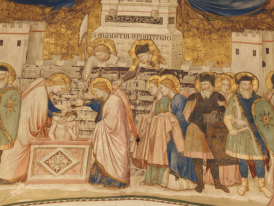
Detailed Renaissance fresco in San Francesco basilica
How to get there: High-speed or regional trains from Firenze Santa Maria Novella to Arezzo station, then walk 10 to 15 minutes following signs toward the historic center and Piazza Grande.
Let a Local Shape Your Day
Skip rigid tours and build your own Florence day trip with a local host who matches your pace, interests, and appetite for detours.Seasonal and Festival Trips: When Tuscany Changes Mood
Tuscany never feels the same for long. Spring smells like jasmine, summer glows late into the evening, autumn turns the vineyards copper, and winter empties the piazzas in the best way. Some day trips from Florence become unforgettable when the timing lines up.
Spring In The Gardens Of Fiesole
Time from Florence: About 25 to 30 minutes by bus
Best for: blooming terraces, soft light, garden walks
Why go: Watch Florence wake up from above, surrounded by flowers and quiet trails.
What to do
- Stroll terraced gardens overlooking Florence
- Visit the Roman theater when spring events begin
- Choose an outdoor café table for a long coffee
- Follow short trails through groves while everything blooms
In spring, Fiesole delivers jasmine on walls and a sun that feels kind instead of harsh. The terraces bloom, the air carries sweetness, and paths up there soften with new grass. The Roman theater sometimes hosts small performances in late spring that feel intimate against stone ruins. Even without a show, sitting with a glass of wine while looking down at Florence wrapped in that light becomes its own performance.
How to get there: Bus 7 from central Florence up to Fiesole’s main square, returning the same way.
Summer Festivals Around Siena and Arezzo
Time from Florence: Siena, about 1 hour 15 minutes by bus; Arezzo, about 35 to 60 minutes by train
Best for: Palio, jousting tournaments, street dinners
Why go: See Tuscany when towns turn their history into living celebrations.
What to do
- Visit Siena around Palio dates in July or August
- Watch trial runs and contrada dinners if you can get a spot
- See Arezzo’s Giostra del Saracino in June or September
- Look for smaller sagre celebrating mushrooms, chestnuts, or wild boar
Summer in Tuscany means festivals. Siena’s Palio takes over the Piazza del Campo, and every conversation seems to revolve around horses and riders. Arezzo’s Giostra del Saracino turns Piazza Grande into a jousting field with knights on horseback. Smaller towns hold food festivals that smell like grills, stews, and seasonal ingredients. It is not relaxing, but it is unforgettable.

Medieval jousting tournament in Arezzo's Piazza Grande
How to get there: Buses from Florence to Siena and trains from Florence to Arezzo, timed to arrive several hours before events begin.
Autumn Harvests In Chianti
Time from Florence: About 1 to 1 hour 30 minutes by bus or train, plus local connection
Best for: harvest season, wine production, vineyard colors
Why go: Watch Chianti work as grapes come in and the landscape shifts to copper and gold.
What to do
- Visit small wineries offering harvest season tastings
- Walk past rows of vines turning red and gold
- Talk with growers about their grapes and soils
- Pair tastings with simple plates of bread, cheese, and salami
Autumn is when Chianti makes complete sense. Vines turn warm colors, the air cools, and wineries harvest grapes by hand. Local producers open their doors and offer tours that feel less formal, sometimes ending in a cantina with bread and salami while someone pours three different wines and explains how they differ. Menus across the region lean into wild boar, porcini, and chestnuts, and everything tastes anchored to season and land.
How to get there: Take a regional train or bus from Florence into Chianti towns such as Greve or Radda, then walk or use local taxis between wineries.
Winter Lights In Lucca
Time from Florence: About 1 hour 20 to 1 hour 35 by regional train
Best for: Christmas markets, quiet walls, evening lights
Why go: Trade crowded streets for a walled town full of winter decorations and warm drinks.
What to do
- Walk the city walls in the cold with nearly empty paths
- Visit Christmas markets in the piazzas for gifts and snacks
- Try vin brulè and roasted chestnuts as the lights come on
- Step into churches when the air outside feels sharp
Lucca in winter is cold and gentle at the same time. The walls stay mostly empty except for joggers, markets fill squares with wooden stalls, and churches offer warmth and silence. A cup of mulled wine in hand, walking those streets as they light up at dusk, makes the whole loop feel like a small celebration.
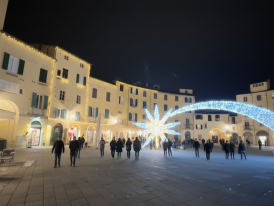
Lucca's oval piazza during winter with Christmas lights
How to get there: Regional trains from Florence to Lucca, then walk from the station straight to the walls and into the center.
Before You Go, Talk to Someone Who Knows
A local video call helps you plan the trip that’s right for you.
Overrated Trips and Their Smarter Alternatives
Not every option lives up to hype, and honesty matters more than politeness here. These are what get skipped, and what happens instead when planning Florence day trips intelligently. Sometimes the real hidden gems in Florence come from knowing what to avoid.
Pisa at Midday
Pisa in the middle of the day, especially in summer, is hard to enjoy. The crowds pack the Piazza dei Miracoli, the heat reflects off the stone, and more time gets spent dodging selfie poses than appreciating architecture. Instead, visit early. Catch a morning connection, arrive before 9 AM, and leave by late morning. Or pair Pisa with Lucca and give the cooler, calmer town your afternoon.
Chianti Coach Tours
Large coach wine tours through Chianti offer convenience but rarely intimacy. You follow a schedule, eat where the company has a contract, and often miss the small conversations that make wine tasting memorable. Instead, rent a car if you are comfortable, or use trains and local buses to reach one or two towns. Spend time at small family wineries, wander village streets, and let the day move on your terms.
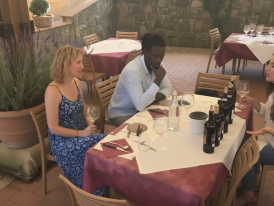
Small family winery with outdoor tasting area
Coach Marathons Through Multiple Towns
Those all-day coaches promising Pisa, Siena, and San Gimignano in one shot leave you tired and unsatisfied. An hour in each place gives just enough time for a main sight and a rushed coffee. It is efficient, but it is not enjoyable. Pick one or two destinations, have a long lunch, leave room to get lost, and let the day feel like life rather than a checklist.
Practical Tips For Planning Your Florence Day Trips
Good planning turns a nice outing into a smooth day from the first platform to the last connection home.
Getting Around Florence and Beyond
- Main station: Most day trips from Florence start at Santa Maria Novella, about a 15-minute walk from the city center. All platforms share one concourse, so check the boards for your number.
- Train types: Regional trains cost less and do not need reservations. High-speed trains require booked seats and connect Florence with larger Italian cities such as Rome and Milan.
- Best choice: For most Florence day trips in Tuscany, regional trains are ideal. They are slower, cheaper, and offer countryside views that suit the pace.
- Tickets: Use the Trenitalia app or website to compare times and skip lines. Paper tickets must be validated in the small machines on the platform. App tickets already carry a travel window.
- Timing: Expect about an hour of travel to many towns, followed by a quick bus ride to reach hilltop centers like Siena or San Gimignano. Check return times early.
Choosing Tours and Experiences
- Wine tours: Small group tours make visiting Chianti wineries easy without driving. Expect tasting fees that sometimes include snacks.
- Cooking classes: Country classes that include transportation and hands-on cooking feel more generous than city options that only let you watch.
- Guided tours: Look for transparent, small operators instead of big buses that cram in multiple towns.
- Food tours: Work best in small groups with guides who know their subject.
- Pacing: Avoid coach marathons. One or two stops with a long lunch beats five rushed photos.

Santa Maria Novella platforms at golden hour with trains
Accessibility and Etiquette Essentials
- Terrain: Many Tuscan towns are hilly with cobbles and steps. Siena and San Gimignano are steep. Lucca is flatter, and its walls have ramp access.
- Families: Strollers struggle on cobbles. Baby carriers often work better.
- Winery etiquette: Call ahead. Many small producers require reservations, and tastings are rarely free.
- Church visits: Cover shoulders and knees with light layers, speak softly, and avoid flash photography.
- Accessibility planning: Research each town’s layout and transport before committing to a route.
Smart Timing and Safety On The Return
- Last trains: Rural lines can thin out after dinner, so always check the final departures before lingering over dessert.
- Plan ahead: Set a phone alarm one hour before your last connection.
- Alcohol and travel: Pace tastings so you can read schedules and move through stations safely.
- If delayed: Missing the last train can mean taxis or an overnight stay. Avoid that surprise with early planning.

Rural and quiet train stop in the late evening
Frequently Asked Questions About Florence Day Trips
1) What is the best day trip from Florence for a first visit?
Siena. It's accessible, offers a completely different medieval atmosphere, and has enough to see for a full day without overwhelming. The Piazza del Campo alone justifies the trip.
2) Can you pair Pisa and Lucca in just a day without rushing?
Yes, with smart timing. Pisa early morning for 2–3 hours, then hop the regional train to Lucca for the afternoon. Both are close enough that it works, but each deserves a full day if you have the time.
3) Is Siena faster by train or bus from Florence?
The bus is slightly faster, at about 1h15 and drops you closer to the historic center. The regional train takes about 1h30–1h45 but offers better views through the Tuscan countryside and arrives at the base of the hill.
4) How long does it take to reach San Gimignano by public transportation?
Figure on 1h45–2h10 total. Regional train to Poggibonsi, then a local bus climbs up to San Gimignano. The connection isn't always immediate, so check schedules ahead.
5) Which day trips from Florence are best for food and wine?
Chianti for wine production and tastings, Greve for Saturday markets and salami shops, Arezzo for traditional Tuscan stews. San Gimignano offers excellent saffron-based dishes if you skip the touristy spots.
6) Is Lucca suitable for travelers with limited mobility?
More so than most Tuscan towns. Lucca is flatter, and the city walls have ramp access, though cobblestones still appear throughout the historic center. It's one of the easier options for accessibility.
7) What's the most scenic rail route from Florence?
The regional train to Siena. It winds through hills, past vineyards and olive groves, with hilltop towns appearing in the distance. Spring and autumn offer the best light and landscape colors.
8) Can I see Leonardo da Vinci's Last Supper on a day trip from Florence?
The Last Supper is in Milan, which requires a high-speed train booking. While it's possible as just a day trip (about 1h50–2h each way by high-speed, route and service dependent), consider whether the journey allows enough time to visit Milan properly beyond the painting. You'll need advance reservations for the Last Supper viewing itself.
9) Are there day trips from Florence with fresh seafood without renting a car?
Head to Livorno, the port city. Plan on about 1h20–1h30 by regional train from Florence. The Mercato Centrale has excellent fresh catch, and waterfront restaurants serve the daily haul without pretense.
10) Which lesser-known towns near Florence are worth a day (Pistoia, Certaldo, Volterra)?
Pistoia for Romanesque churches and authentic market days (40 minutes by train). Certaldo for a medieval atmosphere without crowds. Volterra for Etruscan history and dramatic hilltop setting, though it's about 2h30–3h combined by train and bus from Florence; long for a single day unless you start early.
A Perfect Day Out Under the Tuscan Sun
The espresso still goes down fast at the counter, the ticket still gets tucked into a back pocket, but now the destination matters less than the going itself. Florence is home, with its noise and crowds and that electric energy that never quite turns off. Tuscany is bigger than any one city, and stepping out into the hills or a medieval town for just a day reminds you why this region pulls people back again and again.
The countryside does not demand anything. It just exists, rolling and green and patient. The towns hold their history without turning it into a performance. The food, the wine, those groves catching afternoon light under the Tuscan sun, they stay there whether anyone shows up or not. When the trip happens, when a train or bus leads to somewhere slower, when lunch stretches into three hours on a terrace with nothing but vines around, when the evening return carries a bottle of Chianti wine and the taste of pecorino still lingers, the whole point becomes clear.

Golden sunset over vineyard hills near San Gimignano with towers silhouetted
These Florence day trips are not about counting destinations. They are about pressing pause without stopping completely, about remembering that sometimes the best part of living in Florence is leaving it for a while, knowing it will be there when the train pulls back in. The sun sets the same way over San Gimignano’s towers as it does over the Arno, but somehow it feels different out there in the hills. Warmer, maybe, or just slower. Either way, it is worth the ticket and worth the planning.
These are the kinds of Italy Experiences that stay with you long after the train ride home, the kind that make Tuscany feel less like a destination and more like a place you're always returning to.
Discover More of Italy
Ready to Plan Your Perfect Day in Florence?
Start your experienceWhat if Your Day in Florence Was Planned by Someone Who Knows It — and You?
City Unscripted matches you with a local host who creates a private experience based on your interests, not a set route.
See how it worksWant to Experience the Real Florence With Someone Who Lives There?
A fully private experience, planned and led by a local host who tailors the day to you






